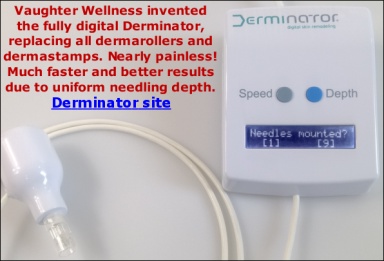Washing the skin with a good cleanser before dermarolling with a 0.2 mm roller is enough but you have to clean the 0.2 mm dermaroller after rolling to remove skin oils and debris. Rinse the roller under running water, then soak it for a short while in a tupperware box with lukewarm water with dishwashing liquid, shake the roller a little (be careful not to hit the walls of the box, but if you don't hit them too hard it doesn't matter because the soft plastic won't blunt the needles). Do not forget to rinse it again under running water to rinse off the detergent and let it dry in a clean place. The whole procedure will take just a minute or two.
For the 0.2mm roller: About every ten days (if you roll every other day), clean the roller as usual and then soak it in disinfecting alcohol:
https://http://forums.owndoc.com/dermarolling-microneedling/can39t-find-proper-disinfection-alcohol/We sell Chloramine-T for roller disinfection.
Young skin without acne does not need Tretinoin cream so it does not matter that you do not have it.
You should use:
(1) before dermarolling, respectively on the days that you do not roll.
And (2), (3) and (4) after dermarolling, There is no need to use all of them after dermarolling. You can use (2) and (3) at the same time but do not mix it with (4). Use (4) separately the next time after dermarolling.
Non-acidic forms of vit. C failed to increase ascorbic acid levels in the skin:
“Derivatives of ascorbic acid including magnesium ascorbyl phosphate, ascorbyl-6-palmitate, and dehydroascorbic acid did not increase skin levels of L-ascorbic acid.”
https://http://www.ncbi.nlm.nih.gov/pubmed/11207686It doesn’t prove that it had no effect on collagen production since this was not studied but further studies are necessary to find out.
So keep using the acidic form (ascorbic acid) as well since this form did increase the levels in the skin.
Last but not least: There has been a lot of prejudice directed towards preservatives but there is no inherent reason for that because preservatives are not harmful per-se. A common preservative is vitamin C, to give just an example. And the human body is literally packed with preservatives (natural antioxidants etc.) Preservatives are necessary to prevent bacterial or fungal growth in food or creams. Preservative-free creams should be stored in the fridge and used up quickly.
Dermarolling enhances skin care creams' penetration into the deep skin layers and using an old preservative-free cream that hasbeen touched many times is not such a good idea.
Creams in tubes do not get contaminated by the hands so if you could fill your DIY cream into a tube, it would be optimal.
It is OK to apply a DIY cream from a jar but always prepare just a small batch and use it up quickly. Otherwise add some preservatives.
Perhaps I am preaching to the choir but there is another popular misconception concerning "natural" versus "chemical". Every substance in the universe is a chemical. Which includes all natural products. Water is a chemical, we are 100% made of chemicals, everything on Earth is comprised of chemicals. A chemical-free product does not exist.
Natural products can be great but do not believe that if something is natural, it is automatically good and harmless.
Some of the most toxic substances are natural - botulinum toxin, uranium, curare etc.
Rotten meat, moldy bread and excrement are also natural.
Toxicity is all in the dose. Even natural products that are not considered toxic are harmful in larger quantities. If you drink more than a few liters of water in one go, you will die of water poisoning (electrolyte imbalance).
Stating that something has no side effects because it is natural is a logical fallacy, and the same with saying that something is harmful because it is artificial.
(I know that you weren't claiming that, you were just stressing the quality of your products, but this was just for the general benefit of the reader and a rant off my chest :-)






